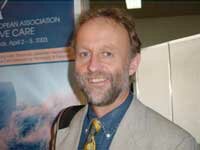 |
President's message 2002
 |
By Stein Kaasa, President EAPC 1999-2005
New developments for the new millennium
The strength and influence of the EAPC really depends upon the contribution of its members
|
The European Association for Palliative Care (EAPC) was established to promote palliative care in Europe and to act as a focus for all of those who work, or have an interest, in the field of palliative care.
The EAPC has grown rapidly since its foundation in 1988 and today consists of 240 individual members and 25 collective member associations representing over 23,000 people.(1)
The strength and influence of the EAPC really depends upon the contribution of its members. The biennial congresses of the EAPC bring members together and have become one of the highlights of the palliative care calendar. The congresses provide opportunities for networking, for keeping in touch with latest developments, and for renewing energy and enthusiasm for the work. However, only a small proportion of the membership is able to attend each congress and the EAPC has developed other initiatives to involve the membership and to promote the discipline. The four networks of the EAPC (Research, Ethics, Education, Policy and Public Health) have served as vehicles for many important developments. They were designed to provide a focus for activities and have allowed many individuals and organisations to contribute to the EAPC through them.
The EAPC's Board of Directors has continually reviewed the structures and organisation of the Association as it has evolved. Recently, the Board has proposed that the activity within the networks may be better organised through specific task forces, which will undertake a particular project with a clearly defined and time-limited objective. For example, in the field of ethics, the Board proposes to set up a task force to update and revise the position paper on euthanasia that was published in the first edition of the European Journal of Palliative Care (EJPC).(2) Members may propose topics or projects to be undertaken by a task force which will be considered by the Board. Details and an application form will soon be available on the EAPC website (eapcnet.org). The structure of the research network will remain as it is. The network's Steering Committee has created a network of collaborating centres around Europe and has recently completed a major study involving a cross-sectional survey of palliative care in 20 different countries. A total of 141 palliative care services took part in the study and the initial results of this investigation were presented at the 1st Congress of the Research Network at Berlin in December 2000.
Communication is a subject of continuing importance within the EAPC. The EAPC website is crucial in this respect and we encourage all members to visit the site regularly. It is also important that members contribute to the website and draw attention to events which could be usefully publicised here.
The EAPC's journal, the EJPC, is a fundamental part of the Association's communication strategy. The journal has the potential to reach a much wider audience and the Board will be making every effort to encourage wider readership and more subscriptions. However, in future, the EAPC Newsletter will not be included in the journal, or distributed as a separate document, but it will be available on the website every quarter. The changes to the organisation of the EAPC will result in more cost-effective working, particularly in the areas previously covered by the networks. Effective communication will also be improved and we are keen to encourage greater participation by the members. Finally, a major initiative for the EAPC will be to facilitate the development of palliative care in Eastern Europe through collaboration with the Soros Foundation and the East and Central European Palliative Care Taskforce (ECEPT). As we begin the 21st century, the EAPC is vibrant and growing. It can only continue with your help, so please join us and join in.
Stein Kaasa, EAPC President, Norway;
Geoffrey Hanks, Immediate Past President, UK
References
1. eapcnet.org
2. Roy DJ, Rapin C-H. Regarding euthanasia. EJPC 1994; 1(1): 5759.
|